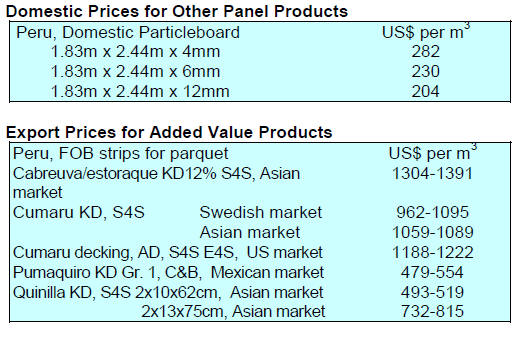2. GHANA
Manufacturing sector – fastest growth in 5 years
Data released by the Ghana Statistical Service is showing
that the manufacturing sector in Ghana is beginning to
recover. An almost 7% increase in output was recorded for
the second quarter of this year, an improvement on the
5.9% growth in the first quarter and the highest quarterly
growth in 5 years.
As previously reported, the manufacturing sector has
suffered in recent years from the energy crisis, the high
cost of power and high taxes. The timber industry has an
additional worry in that log raw materials are in scarce
supply which the government is addressing with extensive
reforestation and afforestation efforts.
Recovering degradation in savannah forests
The Forestry Commission (FC) of Ghana is partnering
with the United Nations Development Programme
(UNDP), to develop the country’s second REDD+
programme, which is focused on reducing deforestation
and forest degradation in savannah forests.
Addressing the 2nd National REDD+ Forum under the
theme “Strengthening Law Enforcement for Effective
REDD+ Implementation”, and organised by the Ministry
of Lands and Natural Resources and the Forestry
Commission, the Ghana President, Nana Addo Dankwa
Akufo-Addo, said efforts to stop deforestation and forest
degradation in Ghana has his government’s full support.
The President tasked the FC with strengthening its law
enforcement measures to curb illegal logging, mining and
unsustainable harvesting of forest products. He also said
law enforcement agencies need to collaborate closely with
the FC and the Ministry of Lands and Natural Resources
to enforce the laws that govern the management of the
countries natural resources.
New tree seed centre
The Ghana media is reporting that, to support efforts in
reforestation and afforestation, a national tree seed centre
has been established through joint efforts of the Ministry
of Lands and Natural Resources and the Forestry Research
Institute of Ghana (FORIG).
The new Minister for Lands and Natural Resources, said
the Centre will be the cornerstone of efforts to revive the
health of Ghana’s forests. The Minister indicated that the
Forestry Commission required about 13 million seedlings
to meet its needs for the national plantation development
programme and it was to meet this demand that the Centre
was established.
For more see:
https://www.businessghana.com/site/news/general/154029/FORI
G-gets-national-tree-seed-centre

3.
SOUTH AFRICA
Evaporating confidence
Analysts write ‘the market is still weak and confidence,
what little remained, is evaporating fast”. On the political
front there is turmoil with the President having shuffled
the Cabinet. Despite the uncertainty the Rand has been
reasonably steady against major currencies which suggests
the uncertainty has already been factored in.
In addition to the political uncertainty, major storms have
lashed both Johannesburg and Durban, the latter being so
bad hit there was extensive damage to the port which had
cease operations for a few days. News reports say three
ships ran aground, equipment was lost and some piers are
still not accessible.
Despite the gloom, recent data from Statistics
South Africa
point to expanded GDP in the second quarter of this year,
which if confirmed, would mean the economy moved out
of recession. Analysts say the growth was driven higher
output from the agriculture sector.
While the overall economy showed signs of growth,
capital investment was reported as haven fallen.
Unsurprisingly, most indicators have been driven down by
the decline in residential construction.
No end of year boost to construction
The final quarter of the year is usually the busiest time of
the year in the building sector but pine mills continue to
build up stocks in the face of weak sales. The extent of
price discounting by pine mills is not yet undermining the
market but if the current market conditions continue into
the New Year competition for sales will become intense.
Many pine mills are feeling the strain of the last round of
log price increases set by the South African Forestry
Company (SAFCOL). In addition, there have been reports
of labour unrest affecting a few mills. Against this
backdrop some owners are talking of ceasing operations
until the market conditions improve.
The woodbased panel market is facing the same market
constraints as affecting pine sawmillers but panel
producers have benefitted from buyers switching from
solid wood to panels in an effort to cut costs.
Hardwood markets kept alive by demand for US timber
In contrast demand for American hardwoods remains are
steady driven by interest in white oak, ash and walnut.
High end furniture manufacturers seem to have enough
work for the time being.
Over the past few weeks traders report some improved
activity in the meranti market but this comes at a time
when consumption had fallen very low so all that can be
said is that there has been a modest recovery. A similar
change has been seen in the iroko market.
As buyers look to cut costs demand for Saligna
(eucalyptus) has also perked up especially as an alternative
to native hardwoods.
Wood in the home and everyday life – a call for
promotion
October saw the conclusion of the “Forestry
Industrialisation Conference” attended by the then Deputy
Minister of Agriculture, Forestry and Fisheries, Bheki
Cele, Mr Dikobe Martins, Deputy Minister of Public
Enterprises, Mr Bulelani Magwanishe, Deputy Minister of
Trade and Industry, as well as many captains of industry.
In an editorial in Sawmilling South Africa, Roy Southey
writes “A unanimous realisation coming out of the
conference was the need for the total South African
forestry sector to work together in promoting the virtues of
our sector, from the growing of trees to the use of timber
and timber derived products in the building of our homes
and everyday lives”.
WoodEX for Africa, July next year
WoodEX for Africa, the largest trade exhibition in Africa
dedicated exclusively to the timber trade, is scheduled for
July 2018. This event offers a unique business and
networking platform to connect, unify and grow the
African timber, tooling and machinery markets.
According to Stephan Jooste, WoodEX for Africa
Director, "The previous fourth edition of WoodEX for
Africa was very well supported by both local and
international exhibitors and visitors alike.
WoodEX for Africa 2018 will showcase innovative timber
and woodworking products and services, such as
woodworking machinery, fixtures and fittings, decking,
flooring, structural timber, timber preservatives and
treatment, sawmilling and logging, pulp and paper
manufacturing, and wood material and veneer production.
See:http://www.timber.co.za/news/article/dates-set-for-woodexfor-
africa-2018
4.
MALAYSIA
Revision of Malaysian timber
standard
Discussions are underway to revise the Malaysian Timber
Standard MS 1401, which describes the grading
requirements for dressed timber, door jambs and
mouldings manufactured from tropical hardwoods and
plantation timbers, MS 1401 was first published in 1996.
The Malaysian Timber Industry Board (MTIB) was
appointed the Standards Development Agency (SDA) for
timber in 2013. An SDA is responsible for the
management as well as the development of standards.
Part of the review process involves public comment, an
important stage in the Malaysian Standard (MS)
development process and a recent consultation was held
with the industry on the new draft MS 1401 “Specification
for Dressed Timber Door Jambs and General Mouldings”.
The purpose of the consultation was to update the timber
industry and stakeholders on the progress of the MS 1401
revision, to obtain feedback and comments on the
proposed changes made to MS 1401. The consultation
provided an opportunity for the industry to share views
related to the development of the standard.
Certified timber at the core of green cities
The Malaysian Timber Certification Council (MTCC)
took part in the recent International Greentech & Eco
Products Exhibition and Conference Malaysia (IGEM)
2017.
MTCC advocated the utilisation of timber certified under
the national certification scheme as a strategic move to
promote the building of greener cities in Malaysia.
MTCC CEO, Yong Teng Koon, said “The call for greener
cities is more than ever crucial with over half of the
world’s population living in cities today.
As we strive to transform our cities into modern,
sustainable living spaces, we must ensure that the
development process, among others, embraces the use of
sustainable materials at its core.
Green cities are about building and living in a sustainable
manner, which includes the use of sustainable material in
our everyday lives and the national certification scheme
empowers specifiers, companies and individuals to do
their part in achieving this. Yong also urged consumers to
join in this endeavour by consciously choosing certified
timber products”.
Firm demand for plywood
Recent reports say the supply of tropical plywood from
both Malaysia and Indonesia is tight in the Japanese
market. This is due mainly to the end of year wet season
when heavy rains cause delays in log supply.
Transportation of logs to the mills is a problem at present
so plywood mills are working with very low log
inventories. This situation will probably improve towards
year end.
According to Ta Ann, a leading Malaysian plywood
manufacturer and exporter based in Sarawak, the price of
its plywood products increased by about US$25 per cu. m
in first half-2017 and with improving demand further price
rises are anticipated.
Sarawak log production
Sarawak’s log production in first half-2017 was around
3.75 million cu.m, out of which 2.94 million cu.m was
from natural forests and 808,000 cu.m from plantations.
According to the Japan Lumber Reports, Sarawak’s
harvest of planted timber could be around 1.6 million cu.m
this year some 300,000 cu.m more than in 2016.
Plywood price update
Plywood traders based in Sarawak reported the following
export prices:
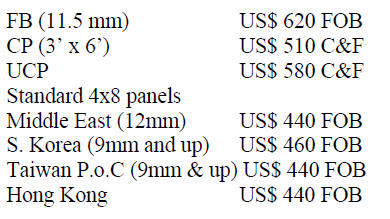
5. INDONESIA
Centre of excellence in wood processing
The Ministry of Industry is claiming some of the credit for
the establishment of a new training facility, the
Polytechnic for the Furniture and Wood Processing
Industries, built in an industrial estate in Kendal, Central
Java.
Analysts write this new development has been designed to
become a centre of excellence in technological innovation
and product development for the wooden furniture and
wood processing industry in the country.
In a press release the Secretary General in the Ministry of
Industry, Haris Munandar, said the Polytechnic will
deliver training on best practices for the sector through
high level vocational education that was initiated by the
Ministry and will create a link between academics and
industry.
Wood must have a great role in housing policy
An urban planning expert from Trisakti University, a
private university in Jakarta, Nirwono Joga, has called for
wood science and technology to be given a place in the
country’s housing policy.
The core of his argument was that wood has many
advantages over other building materials and home
construction costs are lower with wood components, many
of which can be fabricated off-site.
He called on the authorities to help develop the full
potential of wood in domestic housing, saying that a
review of some regulations may be necessary to encourage
more wood use in construction.
Chinese rattan furniture makers eye move to Indonesia
The future of the rattan craft industry in Cirebon, West
Java, is threatened according to Zaenal Arifin from the
Advisory Council of the Indonesian Furniture and Craft
Association (HIMKI).
It has been reported that a number of enterprises have had
to suspend production and decline orders from overseas
buyers because they were unable to secure raw rattan that
comes from Kalimantan, Sulawesi and Sumatra.
Rattan furniture is popular in China and with Indonesia
being the main source of raw rattan the restrictions on raw
rattan exports has worried Chinese rattan enterprises
prompting them to consider shifting production to
Indonesia.
The Indonesian and Chinese governments have been
exploring the feasibility inviting Chinese companies to
locate to Indonesia. Cirebon is known as the centre of the
rattan furniture industry in Indonesia and would be an
obvious place for foreign enterprises to establish
production capacity.
Major wood products producer to expand
A press release from Indonesia Investments has reported
that one of Indonesia's biggest vertically integrated
wooden product manufacturers, Integra Indocabinet, is
planning to expand production using some of the US$24
million derived from its recent initial public offering on
the Indonesia Stock Exchange.
Integra Indocabinet produces indoor and outdoor furniture
as well as wooden doors, wooden window frames and
other wooden and rattan-based products. During the first
half of 2017, around 80% of production was exported.
See: https://www.indonesia-investments.com/business/businesscolumns/
indonesian-wood-furniture-firms-in-focus-integraindocabinet/
item8303
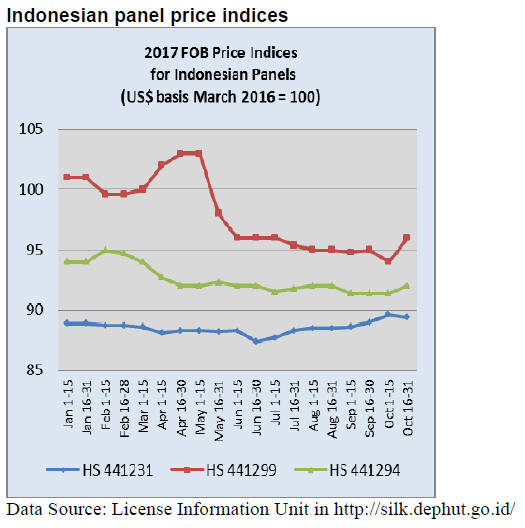
6. MYANMAR
Calls for comprehensive assessment of
harvesting in
Myanmar
Analysts report that representatives of the Myanma
Timber Enterprise (MTE) recently held informal
discussions with representatives of its longtime critic the
Environmental Investigation Agency (EIA).
A report distributed by the EIA earlier this year led the
several authorities in EU responsible for enforcing the
EUTR to call for severe restrictions on timber imports
from Myanmar.
In Denmark action was taken against importers of teak and
in the Netherlands punitive measures were taken against
two companies which placed teak from Myanmar on the
European market.
In both cases it appears that the basis for action in
Denmark and the Netherlands was the EIA report on
Myanmar’s logging.
Barber Cho, Secretary of Myanmar Forest Certification
Committee has expressed disappointment that authorities
in the EU would base their decisions on just one
assessment and has called for more comprehensive and
realistic approach to assessing conditions in Myanmar.
He said “there are a lot of lessons we could take from EIA
reports which are professionally compiled but cannot be
regarded as the sole guide to judge the legality of
Myanmar Timber”.
Cho continued saying the timber industry in Myanmar is
striving to get all stakeholders in the forestry sector to act
responsibly and that such punitive measure as introduced
in some EU member states are uncalled for and
counterproductive as such action could undermine
ongoing efforts to negotiate a VPA with the EU. As yet
there has been no word on the outcome of the meeting
between the MTE and the EIA.
Property tax for investors in industrial zones
Foreign investors who use plots in industrial zones are
required to pay property tax according to Kyaw Zeya,
Secretary of the Yangon Regional Finance, Planning and
Economic Committee.
The issue of land is complicated in Myanmar. Six different
government authorities are tasked with handling land
management and there are many classification of land in
the country which complicates the issue of assigning
industrial plots.
Of concern to potential investors is that Myanmar’s land
rental price are the highest in ASEAN countries. Some
foreign investors attracted by the new investment law
hesitate because of the confusion over land issues even in
industrial zones. Nine MPs have debated a proposal for the
government to free-up idle state-owned lands and
buildings in Yangon region.
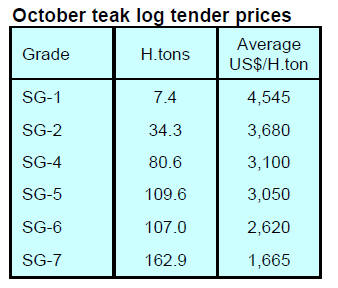
World Bank – Myanmar needs to better
communicate
progress with reforms
Despite some risks especially those related to the ongoing
conflict in Rakhine state, Myanmar’s economy is expected
to recover this year, with growth rising from 5.9% in 2016
to 6.4% this year.
Public and private investments in infrastructure such as
power and transportation are projected to pick up and
inflation is expected to ease according to a press release on
the October 2017 edition of the Myanmar Economic
Monitor.
This report says that despite notable reforms, strong
foreign investment a commitment to further reforms is
needed. The the report also suggests Myanmar build on
(and better communicate) important reforms already
underway. For instance the efforts to provide access to
finance, electricity and land, friendly business regulations
and labour force skills, all of which will boost investor
confidence should be promoted.
For more see
http://www.worldbank.org/en/news/pressrelease/
2017/10/04/myanmars-economy-is-projected-to-pick-upamid-
downside-risks
7. INDIA
Dip in inflation prompts calls for rate
cut
India’s official wholesale price index for all commodities
(Base: 2011-12=100) for September 2017 released by the
Office of the Economic Adviser to the government (OEA)
declined to 114.3 from 114.8 for the previous month rose
by 0.8% to 114.8 from 113.9 in July.
The annual rate of inflation, based on monthly WPI, stood
at 2.6% (provisional) for September 2017 compared to
3.24% for the previous month.
Inflation for this financial year so far was 0.97% compared
to a rate of 3.44% in the corresponding period last year.
The decline in food prices was the foundation for the
decline in inflation. The fall in annualised inflation has
prompted the Confederation of Indian Industry to seek an
interest rate cut.
The September wholesale price index for wood products
and plywood rose to 132.4 from 132.1 for the previous
month due to higher price of plywood and sawnwood.
The press release can be found at:
http://eaindustry.nic.in/cmonthly.pdf
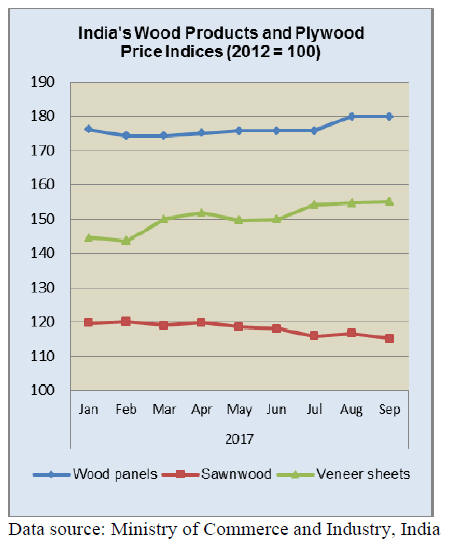
Action to reverse economic slowdown
The Chairman of the Indian Prime Minister's Economic
Advisory Council (PMEAC) has acknowledged the
slowdown in economic activity and said his group will
develop plans that can accelerate growth and employment.
The PMEAC has urged the government to continue with
its policy of fiscal consolidation but avoid the temptation
of a fiscal stimulus package.
The PMEAC has identified priority areas for accelerating
growth including job creation, informal sector integration,
fiscal framework, monetary policy, public expenditure,
agriculture and animal husbandry.
For more see:;http://www.thehindu.com/news/national/pmsadvisory-
committee-acknowledgesslowdown/
article19840741.ece
Auctions in Western Indian forest depots
Auctions at various forest depots in the Surat and Vyara
Division of the Dangs forests have just ended.
Approximately 6,000 cubic metres mainly teak was
offered for sale. Other timbers included Adina cordifolia,
Gmelina arborea, Pterocarpus marsupium, Acacia catechu
and Mitragyna parviflora.
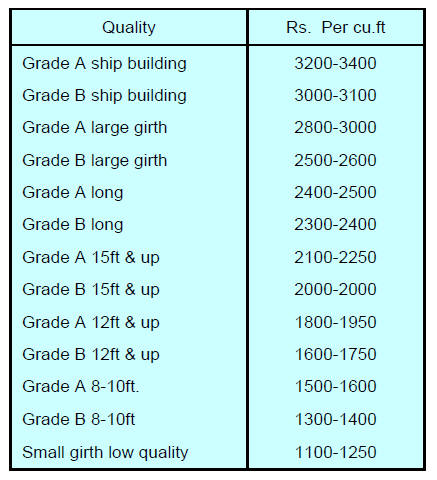
At the Surat and Vyara Division auction good quality
nonteak
hardwood log prices remained firm.
First quality logs of 3 to 4m length with girths of 91 cm &
up of haldu (Adina cordifolia), laurel (Terminalia
tomentosa), kalam (Mitragyna parviflora) and Pterocarpus
marsupium attracted prices from Rs.800 to 900 per cu.ft.
Second quality logs were sold at between s.600 and 700
per cu.ft and the lowest quality logs went for between
Rs.250 to Rs.350 per cu.ft.
Century Ply continues to invest in processing capacity
The Indian construction sector WFM Construction
Industry Market Place website has reported that Century
Plyboards is planning to set up a door manufacturing unit
in collaboration with a Chinese Company.
Century Ply is also close to completing its MDF
plant in
Hoshiarpur in Punjab which will have the capacity to
produce almost 200,000 cubic metres annually making it
one of the largest MDF plants in the country.
For more see:
https://www.wfm.co.in/century-ply-setup-doorunit/
Imported plantation teak
Demand for imported logs remains steady and supplies are
reported as adequate say traders. In the absence of a
decision on the GST from the GST Council no prices
movements have been reported.
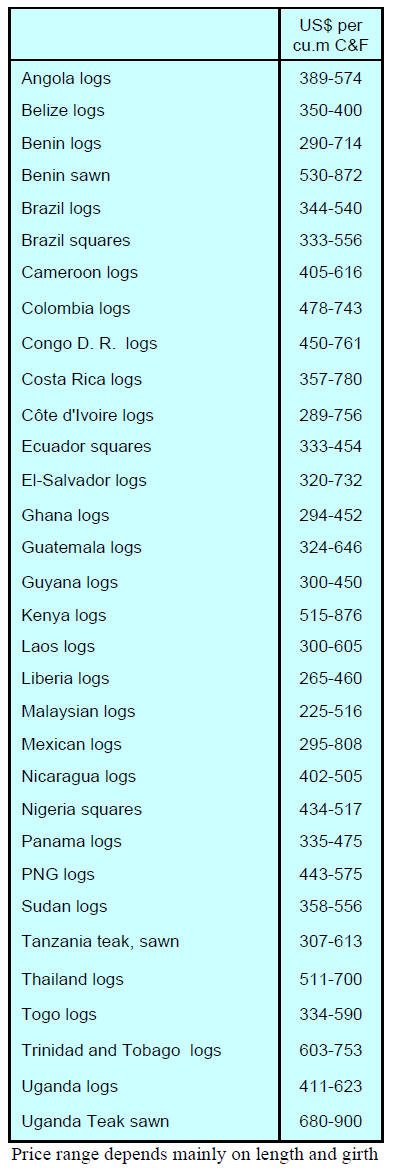
Locally sawn hardwood prices
Prices for imported hardwoods remain unchanged. Traders
report demand is slow which does not allow for any price
increases.

Myanmar teak prices
The arrivals of sawn Myanmar teak are adequate to meet
the slightly lower demand say traders. Due to weaker local
sales the price for some grades has been reduced to
stimulate sales.

Prices for imported sawnwood
Prices for imported sawnwood (KD 12%) remain
unchanged.

Prices for WBP marine grade manufactured by
domestic mills
The slow housing market and the expansion of domestic
plywood production has put a downward pressure on
plywood prices.

8. BRAZIL
Impact of changing US tariffs discussed
During a recent joint-meeting of the Brazilian Association
of Mechanically-Processed Timber Industry (ABIMCI)
and the Paraná State Federation System of Industries
(FIEP) timber industry entrepreneurs discussed the
dynamics of the Brazilian timber sector.
The main issues discussed revolved around market
opportunities and hurdles created by exchange rate
fluctuations, logistics and tariffs on manufactured goods
especially those in the US market.
On exchange rates, specialists forecast that the BRL/US$
rate will remain around BRL 3.10/US$ this year with a
projected slight strengthening in 2018.
FIEP, with support of other institutions (including
ABIMCI), has been working on an investment plan for
logistics, infrastructure and new investments in ports and
railways that can improve the profile and performance of
enterprises in the southern state of Paraná.
The plan aims at reducing logistics costs and guaranteeing
energy supplies.
During the meeting the status of the US tariffs on Chinese
plywood exporters was discussed as was the likely
outcome of the negotiations on a revised North American
Free Trade Agreement.
It was noted that, at present, Canada supplies around 90%
of the sawnwood consumed in the US and that any change
to import tariff on Canadian sawnwood and plywood will
need to be carefully monitored.
Production of native timber declines
According to data from the Brazilian Institute of
Geography and Statistics (IBGE), production of native
timber fell almost 10% in 2016 compared to a year earlier.
The figure quoted by IBGE included production of
firewood for charcoal, fuelwood and industrial logs.
Extraction of hardwood logs from natural forests fell by
7% in 2016 compared to 2015 from 12.3 million cu.m to
11.5million cu.m. The northern Brazilian states of
Rondônia and Pará reported the most significant declines
in native timber production, dropping 23% and 21%
respectively.
On the other hand, production of native timber in the westcentral
state of Mato Grosso rose 8% last year to 3.3
million cu.m compared to 2015 when 3.1 million cu.m
were produced. However, despite the increased production
in Mato Grosso, national production declined.
Production of logs for charcoal from natural forests also
dropped 32% in the same period, from 797,000 cu.m
(2015) to 544,500 cu.m (2016). Extraction of native timber
fuelwood also fell 7%, from 27.0 million cu.m to 25.0
million cu.m.
Analysts comment that the decline in production from
natural forests is most likely the result of the recently
enacted environmental legislation and stronger
enforcement as well as the unavailability of labour in
remote areas.
Export roundup
In September 2017, Brazilian exports of wood-based
products (except pulp and paper) increased 25.0% in value
compared to September 2016, from US$201.2 million to
US$251.5 million.
Pine sawnwood exports in value increased 19% from
September 2016 (US$ 35.3 million) and September 2017
(US$ 41.9 million). In volume terms, exports rose 12%
over the same period from 181,100 cu.m to 202,500 cu.m.
Tropical sawnwood exports expanded 41% in September
2017 from 30,200 cu.m in September 2016 to 42,500 cu.m
this year. The value of September tropical sawnwood
exports jumped 38% from US$14.1 million to US$ 19.5
million this year. The good news continued with the value
of pine plywood exports which expanded 36% in
September 2017 from US$ 35.8 million a year earlier to
US$ 48.7 million this September. In volume terms
September 2017 exports were up 24%.
As for tropical plywood, Brazilian exports were 23.5%
higher in volume and 17% higher in value, from 13,200
cu.m (US$ 5.4 million) in September 2016 to 16,300 cu.m
(US$ 6.3 million) in September 2017.
Exports of wooden furniture from Brazil increased from
US$ 35.7 million in September 2016 to US$ 40.4 million
in September 2017, a 13% increase.
Strengthen forest industries to meet GGE goals
The Mato Grosso Timber Production and Export
Industries Center (Cipem), a union of eight forest-based
employers' unions, has said strengthening the Brazilian
forest-based industry will help the country to fulfill the
commitment made with the Paris Agreement.
Brazil committed to reduce its greenhouse gas emissions
(GGE) by 2025 and one measures proposed to achieve this
goal is the restoration and reforestation of 12 million
hectares by 2030.
For this to be achieved it will be necessary to enlist the full
support of private forestry sector.
A greater utilisation of wood in construction could
contribute to reducing GGE by the construction sector.
Some environmental agencies have been working in
partnership to show the benefits and opportunities from
using wood in architectural projects through adapting
technologies already used in other countries.
The Brazilian Tree Industry (IBÁ) has reported that forest
plantations in Brazil are able to store nearly 1.7 billion
ton/year of carbon dioxide.
Climate Fund - cash to reward declines in
deforestation
It has been reported that the Green Climate Fund (GFC)
approved a US$500 million package of support for
developing countries that prove reduction in deforestation
by 2022. Brazil is seeking around US$150 million for its
efforts in reducing deforestation in the Amazon and in the
Cerrado (Brazilian savannah) ecosystems between 2014
and 2018.
The GFC package offers US$5 per tonne of reduced
carbon which is a good opportunity for countries with
large forest areas and a high potential to reduce carbon
emissions through avoiding deforestation.

9.
PERU
SERFOR and Ucayali government
cooperation
In order to further develop strategies to strengthen forestry
and wildlife management the National Forestry and
Wildlife Service (Serfor) and the Regional Government of
Ucayali signed an inter-institutional support agreement.
The Executive Director of Serfor, John Leigh and the
General Manager of the Regional Government of Ucayali,
Luis Briceño, inked the agreement which consolidates
actions for the benefit of Amazon.
Leigh stressed that this was the first agreement by Serfor
with a regional government to whose authority for forest
and wildlife management has been expanded.
As part of the agreement Serfor will have a liaison office
in the headquarters of the regional government of Ucayali
and will be provided with basic services to facilitate
coordination and implementation of work. This agreement
runs for two years with the option for extension.
ITTC in the national interest say President
The President of the Republic, Pedro Pablo Kuczynski,
said that the upcoming international tropical timber event
to be held in Lima is of national interest.
Through Supreme Decree No. 012-2017 MINAGRI the
Peruvian State declared the Fifty-third Session of the
International Tropical Timber Council (ITTC) to be held
in in Lima is in the national interest. Peru will host the
ITTC in Lima from November 27 to December 2, 2017.
Regional forestry and wildlife monitoring board
In order to coordinate joint action a Regional Forestry and
Wildlife Control and Surveillance Bureau (MRCVFFS)
has been established in Ucayali. The new bureau brings
together participation of the Regional Government and ten
public institutions responsible for sector issues.
The Executive Director of Serfor said that this initiative
has the backing of the National Forest and Wildlife
Control and Surveillance System (SNCVFFS) as there will
be cooperation and joint work utilising up-to-date
technologies and surveillance methods to strengthen the
capacity to eliminate deforestation, illegal logging and
trafficking in wildlife and timber.
At next meeting is scheduled for the second half of
November when the Bureau will seek to identify
additional stakeholders from the public sector and civil
society that are allied to forest control and monitoring
activities.
The SNCVFFS, led by Serfor. works with the Satellite
Monitoring Unit in order to issue alerts on land use
change.

